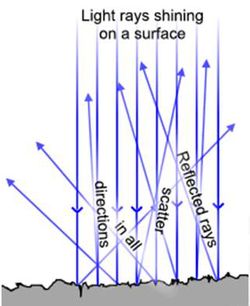Optical light-based inspection can be tricky if the part being inspected is transparent or reflective. In this article we’ll explain why the challenge exists and how it is easily overcome for 3D scanning projects.
 3D laser scanners like ShapeGrabber’s use the principle of diffuse reflection, wherein reflected light scatters in many directions off of an uneven or granular surface (illustrated in the top image to the right). This is in contrast to specular reflection, such as that which occurs when a ray of light hits a very smooth surface like a mirror, and all light is reflected at the same angle (illustrated in the second image).
3D laser scanners like ShapeGrabber’s use the principle of diffuse reflection, wherein reflected light scatters in many directions off of an uneven or granular surface (illustrated in the top image to the right). This is in contrast to specular reflection, such as that which occurs when a ray of light hits a very smooth surface like a mirror, and all light is reflected at the same angle (illustrated in the second image).
At a microscopic level, most surfaces have some amount of granularity, and our 3D scanners rely on this characteristic to gather information from the surface of objects. Specifically, the scanners collect data as some of the diffusely reflected light makes its way back to the camera.
Translucent parts present a challenge to 3D laser scanners because light is not reflected from the object’s surface but is instead scattered throughout the volume of the part.
Highly reflective (shiny) parts present a challenge because the light reflects specularly off of the surface, which can cause either of two problems:
- All light reflects off the surface and no signal gets back to the camera
- Light reflects off of the part and onto another surface, resulting in a second image and unwanted scan data
A simple solution is available to enable effective optical non-contact 3D inspection for either case. By coating (spraying) transparent or glossy parts with a  temporary, water soluble anti-reflective paint, we turn transparent or shiny parts into matte solid objects. The spray is simply rinsed off the part after inspection.
temporary, water soluble anti-reflective paint, we turn transparent or shiny parts into matte solid objects. The spray is simply rinsed off the part after inspection.
ShapeGrabber 3D scanners are particularly tolerant of reflective surfaces, offering some of the lowest sensitivity to reflections among industrial 3D laser scanners. For example, machined aluminum parts and cold-rolled steel parts generally do not require a spray coating prior to scanning with a ShapeGrabber system – even if the same part has required coating for use with another 3D scanner in the past.
The only way to find out if a part will require spray is to try it in the scanner. We offer free sample part scans for qualifying parts.
